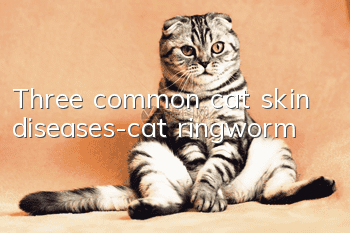Three common cat skin diseases-cat ringworm

Three common cat skin diseases - ringworm. Nowadays, more and more people are raising cats. Having a cute cat by your side is also a happy thing in life. But feces scrapers should also pay attention to the physical health of cats. After all, cat illness has a great impact on both the cat and its owner. Cats are prone to skin diseases. Below, the editor of Boqi.com will introduce three common cat skin diseases. I hope it will be helpful to everyone.
Cats
1. Flea allergic dermatitis: As the name suggests, small red papules appear on the wounds after flea bites. The wounds appear after the cat scratches due to itching. Sometimes Wounds can also be combined with fungal and bacterial infections, making the lesion area larger and larger.
2. Scabies: This is a type of scabies that first parasitizes in the ears, then attacks the head, and then the whole body. When this insect eats the dander tissue of animals, it will cause severe inflammation. It is itchy, so when you find that the kitten is constantly scratching its ears and shaking its head, you should pay attention. It may even have scabs, ulcers, pustules... Please do not continue to "observe" it, and send it to the hospital for treatment as soon as possible!
3. Ringworm: Cats under one year old are easily infected with ringworm, which is a special kind of mold. The typical symptoms are that the hair loss area appears irregular and round, mixed with scaly spots and scars, sometimes mixed with Allergic papules and ringworm are highly contagious and common to humans and animals. Once discovered, they must be treated and controlled as soon as possible.
If the kitten has suffered from skin diseases, its related utensils should be thoroughly disinfected, and the surface should be scrubbed or sprayed with 0.5% bleach solution. If the kitten is exposed to sunlight, it should be kept in the sun for 5 to 6 hours a day, continuously. Weeks, the effect will be better. It is best to expose the cat to the sun until it recovers from treatment. Since mold will survive in the form of spores, after the cat treatment is effective, it will continue for about one week to ten days. The same goes for disinfection of utensils, so as to avoid the chance of recurrence. Otherwise, the remaining mold spores can still survive and lurk for up to 3 days. ,4 years.
- Cat body language, 15 tips for interpreting behavior
- What should I do if my kitten has a cold to get better quickly?
- Is it normal for cats to sneeze in winter?
- Will cats be poisoned if they smell toilet water?
- Will a cat found on the road recognize its new owner?
- Cats will starve to death if they don’t eat for a few days
- Cats eat vitamin b1
- Can cats be bitten by mosquitoes?
- How to tell if a cat is breathing abdominally
- How to judge the appearance of a German Curl cat



